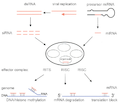Gene silencing facts for kids
Gene silencing is a cool way your body controls its genes. Think of it like a light switch for genes – it can "turn off" a gene so it doesn't make a specific protein. This is different from genetic engineering, which changes the gene itself. Instead, gene silencing uses special tools inside your cells to stop a gene from working, even if the gene itself is perfectly fine.
When a gene is silenced, it means the instructions (called RNA) that usually come from that gene can't be used to build a protein. This is important because proteins do most of the work in your cells.
Your body regulates genes at different stages. It can stop a gene from being copied (this is called transcription), or it can stop the copy from being used to make a protein (this is called translation).
Contents
How Genes Are Turned Off
Stopping Genes at the Copying Stage
One way to silence a gene is to stop it from even being copied. This is called transcriptional gene silencing. Imagine a book in a library. If you put a big, sticky cover over the book, no one can open it to read or copy it.
In your cells, this happens when special proteins called histones change. These changes can make the DNA around a gene very tightly packed. This tight packing is called heterochromatin. When the DNA is packed so tightly, the cell's copying machines (like RNA polymerase and transcription factors) can't reach the gene to make a copy.
Another way genes are silenced at this stage is through something called DNA methylation. This is like putting tiny chemical tags on the DNA itself. These tags can tell the cell to ignore that gene. This process happens all the time as you grow and develop. For example, some genes are turned on when you're a baby and then turned off as you get older.
Stopping Genes After They're Copied
Another way to silence a gene is to stop its instructions (the mRNA) from being used to make a protein. This is called post-transcriptional gene silencing. Imagine you've copied a recipe, but someone rips up the copy before you can use it to bake a cake.
A common way this happens is through a process called RNAi. In RNAi, tiny pieces of RNA find the mRNA instructions from a specific gene and either block them or destroy them. If the mRNA is destroyed, it can't be translated into a protein. This means the gene's "message" never gets delivered.
Why Gene Silencing Matters
Both types of gene silencing are super important for keeping your cells healthy and working correctly.
- Controlling Cell Jobs: Gene silencing helps cells do their specific jobs. For example, a skin cell needs different genes turned on than a brain cell. Gene silencing makes sure only the right genes are active in the right places.
- Protecting Your Body: Gene silencing also acts like a tiny immune system inside your cells. It helps protect your body from harmful invaders like viruses and jumping genes called transposons. If a virus tries to take over a cell, gene silencing can sometimes shut down the virus's genes, stopping it from making more copies.
Gene silencing is a fascinating and ancient way that living things control their genes and stay safe.
Images for kids
See also
 In Spanish: Silenciamiento génico para niños
In Spanish: Silenciamiento génico para niños





